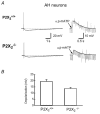P2X2 subunits contribute to fast synaptic excitation in myenteric neurons of the mouse small intestine
- PMID: 12937291
- PMCID: PMC2343442
- DOI: 10.1113/jphysiol.2003.047944
P2X2 subunits contribute to fast synaptic excitation in myenteric neurons of the mouse small intestine
Abstract
P2X receptors are ATP-gated cation channels composed of one or more of seven different subunits. ATP acts at P2X receptors to contribute to fast excitatory postsynaptic potentials (fEPSPs) in myenteric neurons but the subunit composition of enteric P2X receptors is unknown. These studies used tissues from P2X2 wild-type (P2X2+/+) and P2X2 gene knockout (P2X2-/-) mice to investigate the role of this subunit in enteric neurotransmission. Intracellular electrophysiological methods were used to record synaptic and drug-induced responses from ileal myenteric neurons in vitro. Drug-induced longitudinal muscle contractions and peristaltic contractions of ileal segments were also studied in vitro. Gastrointestinal transit was measured as the progression in 30 min of a liquid radioactive marker administered by gavage to fasted mice. RT-PCR analysis of mRNA from intestinal tissues and data from immunohistochemical studies verified P2X2 gene deletion. The fEPSPs recorded from S neurons in tissues from P2X2+/+ mice were reduced by mecamylamine (nicotinic cholinergic receptor antagonist) and PPADS (P2X receptor antagonist). The fEPSPs recorded from S neurons from P2X2-/- mice were unaffected by PPADS but were blocked by mecamylamine. ATP depolarized S and AH neurons from P2X2+/+ mice. ATP depolarized AH but not S neurons from P2X2-/- mice. alpha,beta-Methylene ATP (alpha,beta-mATP)(an agonist at P2X3 subunit-containing receptors) did not depolarize S neurons but it did depolarize AH neurons in P2X2+/+ and P2X2-/- mice. Peristalsis was inhibited in ileal segments from P2X2-/- mice but longitudinal muscle contractions caused by nicotine and bethanechol were similar in segments from P2X2+/+ and P2X2-/- mice. Gastrointestinal transit was similar in P2X2+/+ and P2X2-/- mice. It is concluded that P2X2 homomeric receptors contribute to fEPSPs in neural pathways underlying peristalsis studied in vitro.
Figures












Similar articles
-
Peristalsis is impaired in the small intestine of mice lacking the P2X3 subunit.J Physiol. 2003 Aug 15;551(Pt 1):309-22. doi: 10.1113/jphysiol.2003.044172. Epub 2003 Jun 17. J Physiol. 2003. PMID: 12813150 Free PMC article.
-
P2X purinoceptors in cultured myenteric neurons of guinea-pig small intestine.J Physiol. 1996 Nov 1;496 ( Pt 3)(Pt 3):719-29. doi: 10.1113/jphysiol.1996.sp021722. J Physiol. 1996. PMID: 8930839 Free PMC article.
-
A novel calcium-sensitive potassium conductance is coupled to P2X3 subunit containing receptors in myenteric neurons of guinea pig ileum.Neurogastroenterol Motil. 2007 Nov;19(11):912-22. doi: 10.1111/j.1365-2982.2007.00952.x. Epub 2007 Jul 18. Neurogastroenterol Motil. 2007. PMID: 17973642 Free PMC article.
-
Molecular physiology of P2X receptors.Physiol Rev. 2002 Oct;82(4):1013-67. doi: 10.1152/physrev.00015.2002. Physiol Rev. 2002. PMID: 12270951 Review.
-
P2X receptors in peripheral neurons.Prog Neurobiol. 2001 Oct;65(2):107-34. doi: 10.1016/s0301-0082(01)00005-3. Prog Neurobiol. 2001. PMID: 11403876 Review.
Cited by
-
Electrophysiological characteristics of enteric neurons isolated from the immortomouse.Dig Dis Sci. 2013 Jun;58(6):1516-27. doi: 10.1007/s10620-013-2557-5. Epub 2013 Jan 31. Dig Dis Sci. 2013. PMID: 23371009 Free PMC article.
-
The intracellular amino terminus plays a dominant role in desensitization of ATP-gated P2X receptor ion channels.J Biol Chem. 2011 Dec 30;286(52):44691-701. doi: 10.1074/jbc.M111.303917. Epub 2011 Oct 25. J Biol Chem. 2011. PMID: 22027824 Free PMC article.
-
Drosophila taste neurons as an agonist-screening platform for P2X receptors.Sci Rep. 2020 May 19;10(1):8292. doi: 10.1038/s41598-020-65169-9. Sci Rep. 2020. PMID: 32427920 Free PMC article.
-
Covalent modification of mutant rat P2X2 receptors with a thiol-reactive fluorophore allows channel activation by zinc or acidic pH without ATP.PLoS One. 2012;7(10):e47147. doi: 10.1371/journal.pone.0047147. Epub 2012 Oct 24. PLoS One. 2012. PMID: 23112811 Free PMC article.
-
Optogenetic analysis of neuromuscular transmission in the colon of ChAT-ChR2-YFP BAC transgenic mice.Am J Physiol Gastrointest Liver Physiol. 2019 Nov 1;317(5):G569-G579. doi: 10.1152/ajpgi.00089.2019. Epub 2019 Aug 14. Am J Physiol Gastrointest Liver Physiol. 2019. PMID: 31411893 Free PMC article.
References
-
- Abdu F, Hicks GA, Hennig G, Allen JP, Grundy D. Somatostatin sst(2) receptors inhibit peristalsis in the rat and mouse jejunum. Am J Physiol. 2002;282:G624–633. - PubMed
Publication types
MeSH terms
Substances
Grants and funding
LinkOut - more resources
Full Text Sources
Molecular Biology Databases
Research Materials

